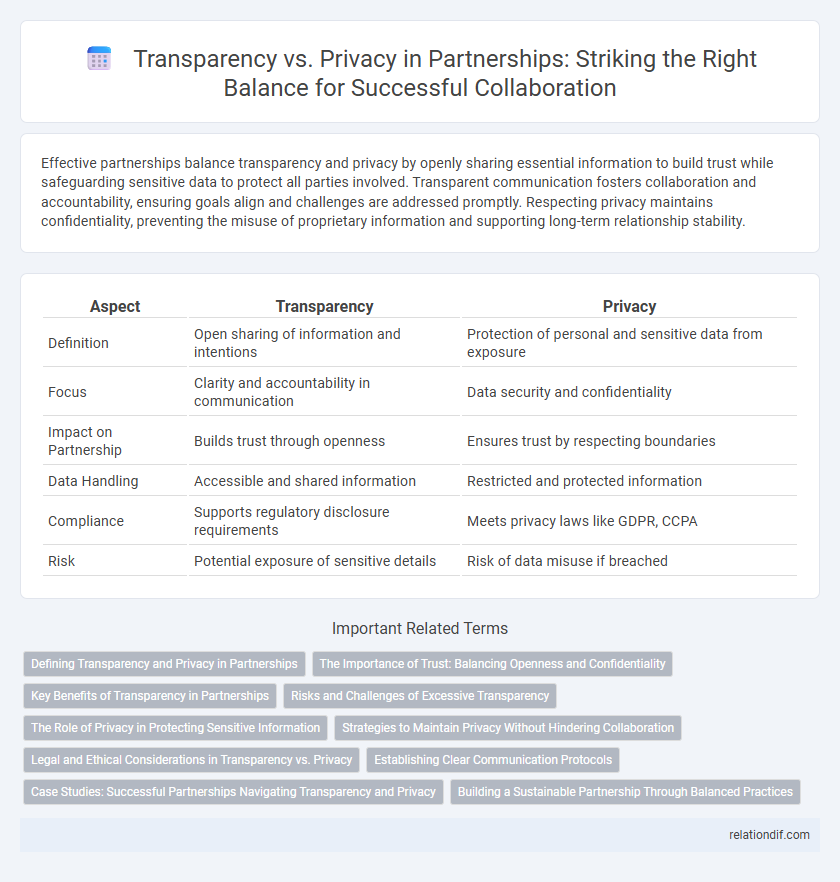Effective partnerships balance transparency and privacy by openly sharing essential information to build trust while safeguarding sensitive data to protect all parties involved. Transparent communication fosters collaboration and accountability, ensuring goals align and challenges are addressed promptly. Respecting privacy maintains confidentiality, preventing the misuse of proprietary information and supporting long-term relationship stability.
Table of Comparison
| Aspect | Transparency | Privacy |
|---|---|---|
| Definition | Open sharing of information and intentions | Protection of personal and sensitive data from exposure |
| Focus | Clarity and accountability in communication | Data security and confidentiality |
| Impact on Partnership | Builds trust through openness | Ensures trust by respecting boundaries |
| Data Handling | Accessible and shared information | Restricted and protected information |
| Compliance | Supports regulatory disclosure requirements | Meets privacy laws like GDPR, CCPA |
| Risk | Potential exposure of sensitive details | Risk of data misuse if breached |
Defining Transparency and Privacy in Partnerships
Transparency in partnerships involves open communication, clear sharing of information, and mutual accountability, ensuring all parties are informed about decisions, strategies, and financial matters. Privacy focuses on protecting sensitive data, respecting confidentiality agreements, and limiting access to proprietary information to safeguard competitive advantages. Balancing transparency and privacy establishes trust while preserving essential safeguards critical for successful collaboration.
The Importance of Trust: Balancing Openness and Confidentiality
Trust forms the foundation of successful partnerships by balancing transparency and privacy to ensure mutual confidence. Transparent communication promotes accountability and alignment of goals, while safeguarding sensitive information preserves confidentiality and competitive advantages. Striking the right balance between openness and discretion fosters long-term collaboration and strengthens the partnership's resilience.
Key Benefits of Transparency in Partnerships
Transparency in partnerships fosters trust by providing clear communication and accountability between parties, reducing misunderstandings and conflicts. It enables better decision-making through open access to relevant information, ensuring all partners are aligned with shared goals. Enhanced transparency also strengthens long-term collaboration by building confidence and promoting a culture of honesty.
Risks and Challenges of Excessive Transparency
Excessive transparency in partnerships can expose sensitive information, increasing the risk of data breaches and competitive disadvantage. Over-sharing internal strategies or financial details may undermine trust and lead to conflicts among partners. Balancing openness with privacy safeguards is crucial to mitigate risks and maintain a secure, collaborative environment.
The Role of Privacy in Protecting Sensitive Information
Privacy plays a critical role in safeguarding sensitive information within partnerships by ensuring data confidentiality and preventing unauthorized access. Implementing robust privacy measures such as encryption, access controls, and compliance with data protection regulations like GDPR enhances trust between partners. Maintaining privacy not only protects proprietary data but also mitigates risks related to data breaches and legal liabilities.
Strategies to Maintain Privacy Without Hindering Collaboration
Maintaining privacy in partnerships requires implementing clear data governance policies that define access levels while ensuring transparency in shared information. Utilizing encryption tools and secure communication platforms protects sensitive data without obstructing open collaboration channels. Regular audits and consent-based data sharing agreements balance trust and confidentiality, fostering a productive and secure partnership environment.
Legal and Ethical Considerations in Transparency vs. Privacy
Legal frameworks such as the General Data Protection Regulation (GDPR) impose strict guidelines on data transparency, balancing the right to privacy with organizational accountability. Ethical considerations demand that partnerships implement clear consent mechanisms and data minimization to prevent misuse of personal information. Transparent communication fosters trust while ensuring compliance with privacy laws and ethical standards in data sharing.
Establishing Clear Communication Protocols
Establishing clear communication protocols in partnerships ensures transparency while respecting privacy boundaries, fostering trust among stakeholders. Defining specific channels, frequency, and confidentiality levels aligns expectations and mitigates misunderstandings. Structured communication protocols enhance accountability and enable timely information sharing, balancing openness with necessary discretion.
Case Studies: Successful Partnerships Navigating Transparency and Privacy
Successful partnerships balance transparency and privacy by implementing clear data-sharing protocols and consent frameworks, exemplified by the collaboration between Apple and IBM, where user data privacy was maintained while enabling enterprise insights. Another case is the partnership between Microsoft and LinkedIn, which leverages transparency in data usage to enhance user trust without compromising sensitive information. These examples highlight strategic transparency measures combined with robust privacy safeguards to foster trust and compliance in joint ventures.
Building a Sustainable Partnership Through Balanced Practices
Building a sustainable partnership requires a careful balance between transparency and privacy to foster trust and protect sensitive information. Clear communication of shared goals and data handling policies enhances mutual understanding while safeguarding proprietary business insights. Implementing transparent yet secure processes ensures partners remain accountable without compromising confidentiality, promoting long-term collaboration and growth.
Transparency vs Privacy Infographic

 relationdif.com
relationdif.com